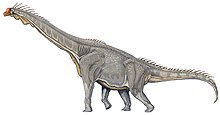
Description
Like all sauropod dinosaurs, Brachiosaurus was a quadrupedal animal with a small skull, a long neck, a large trunk with a high-ellipsoid cross section, a long, muscular tail and slender, columnar limbs.[1] The skull had a robust, wide muzzle and thick jaw bones, with spoon–shaped teeth. As in Giraffatitan, there was an arch of bone over the snout and in front of the eyes that encircled the nasal opening, although this arch was not as large as in its relative.[2] Large air sacs connected to the lung system were present in the neck and trunk, invading the vertebrae and ribs, greatly reducing the overall density.[3][4] Unusually for a sauropod, the forelimbs were longer than the hind limbs. The humerus (upper arm bone) of Brachiosaurus was relatively lightly built for its size,[5] measuring 2.04 metres (6.7 ft) in length in the type specimen.[6] The femur (thigh bone) of the type specimen was only 2.03 metres (6.7 ft) long.[6] Unlike other sauropods, Brachiosaurus appears to have been slightly sprawled at the shoulder joint,[5] and the ribcage was unusually deep.[6] This led to the trunk being inclined, with the front much higher than the hips, and the neck exiting the trunk at a steep angle. Overall, this shape resembles a giraffe more than any other living animal.[7]
Size
Because "Brachiosaurus" brancai (Giraffatitan) is known from much more complete material than B. altithorax, most size estimates for Brachiosaurus are actually for the African form. There is an additional element of uncertainty for North American Brachiosaurus because the most complete skeleton appears to have come from a subadult.[5] Over the years, the mass of B. altithorax has been estimated as 35.0 metric tons (38.6 short tons),[7]43.9 metric tons (48.4 short tons),[8] 28.7 metric tons (31.6 short tons)[5] and, most recently, 56.3 metric tons (62.1 short tons).[9] In cases when the authors also provided estimates for Giraffatitan, and found that genus to be somewhat lighter (31.5 metric tons (34.7 short tons) for Paul [1988],[7] 39.5 metric tons (43.5 short tons) for Mazzetta [2004],[10] 23.3 metric tons (25.7 short tons) for Taylor [2009],[5] or 34 metric tons (37 short tons) for Benson et al [2014]).[9] The length of Brachiosaurus has been estimated at 26 metres (85 ft).[11]


No comments:
Post a Comment